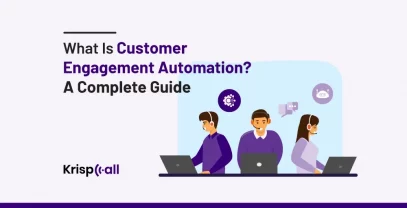Are you ready for enterprise transformation to reach a height of business growth 📈and innovation?🤔
Well, a well-developed enterprise transformation is a way to transform your business to deliver an exceptional customer experience. It helps to boost revenues ⬆️, increase operational efficiency, and improve customer satisfaction.
Moreover, It involves identifying an area of transformation, adopting new technologies, and developing a process for products and services to adjust to an evolving market.
In this blog✍️, we will discuss enterprise transformation and its role in business growth and innovation. We will also cover the implementation strategies and essential components of enterprise transformation.
🔑KEY HIGHLIGHTS
- Enterprise transformation is the process of changing the way that a business operates to offer an exceptional customer experience for business growth and innovation.
- Enterprise transformation includes changes in the team structure, core technologies, product and service developments, and the selling process.
- The essential components of enterprise transformation are digital transformation, solution transformation, and data transformation.
- Transformation, Optimization, and Control are the key phases of enterprise transformation.
- Enterprise transformation offers numerous benefits to businesses, such as increased operational efficiency, improved customer experiences, a boost in revenues, innovation, and business growth.
- For successful enterprise transformation, businesses should set clear objectives and strategies, engage stakeholders and employees, adopt changes in various aspects, establish effective governance, and create and sustain long-term value.
Let’s get started.🚀
What Is Enterprise Transformation?
Enterprise transformation is a change in the way an organization operates, aiming to deliver exceptional customer experience. The change may involve team structures, core technologies, product management and services, decision-making processes, and selling strategies.
In simple words, enterprise transformation is adopting new technologies and steps to grow and modernize your business. It transforms an enterprise’s operations, offers a better customer experience, and increases organizational efficiency.
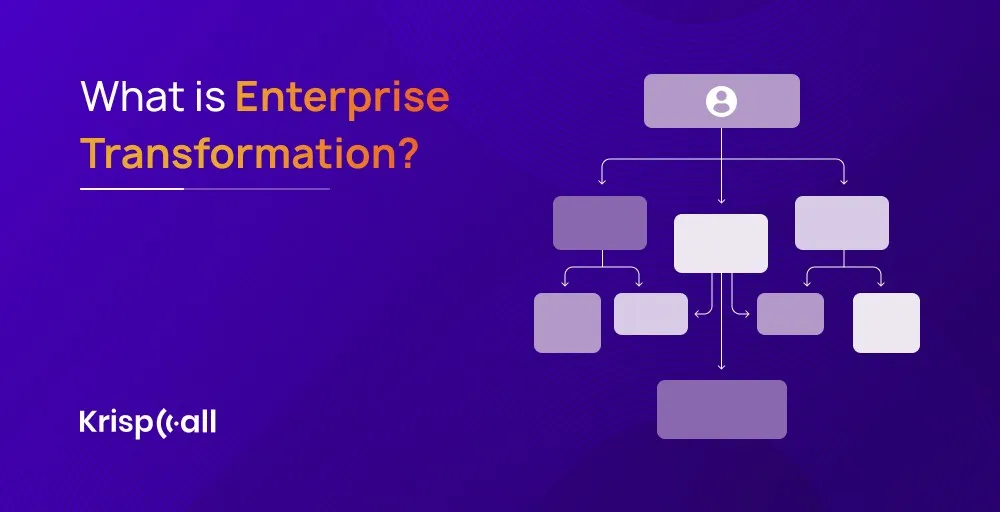
The three essential components of enterprise transformation are:
- Digital Transformation: Digital transformation means investing in technology and processes to change an enterprise’s system and structure. Small businesses can easily benefit from digital transformation with UCaaS.
- Solution Transformation: Solution transformation refers to transforming the process of developing a product to enhance customer relationships and outcomes.
- Data Transformation: Data transformation means using data and analytics to adapt innovations and decision-making processes.
Each component can be adopted separately, but many enterprises combine all three strategies to increase the values they deliver to their customers.
Examples of enterprise transformation are business process, organizational or cultural, and product/ solution transformation.
What Are The Key Phases Of The Enterprise Transformation Process?
Enterprise transformation means transforming the organizational structure, processes, technology, product management, and selling strategy to achieve the organizational goal and satisfy customers.
The enterprise transformation process includes several key phases for successful transformation. The key phases of the enterprise transformations are listed below:
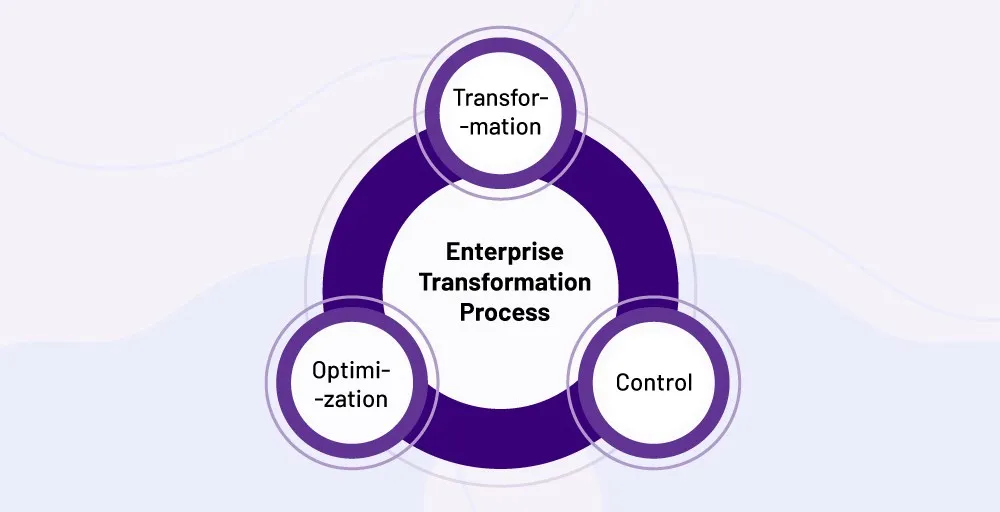
Transformation
The transformation phase realizes the need for changes in the business process. It involves identifying the need for changes in the enterprise’s process, systems, structures, and technology. Making business decisions that align with strategic goals and market trends is essential. It is a phase to make clear plans or a roadmap for successful transformation.
Optimization
In this optimization phase, enterprises implement the planned transformation correctly and check whether the change transformation plan works. To improve effectiveness, they collect feedback, examine performance metrics, and continuously monitor the transformation process.
Control
The control phase is a stage where the enterprise transformation is observed to trace the progress and ensure transformation phases are working as planned. Enterprises should observe the transformation phase and track it in detail. The transformation should be flexible to make further changes if needed to align with business goals and market trends.
What Advantages Does Enterprise Transformation Offer To Businesses?
Enterprise transformation offers various advantages to businesses at low cost. It reduces a business’s operating costs. It drives business growth and innovation, increases operational efficiency, and improves customer experience.
Let’s explain the advantages offered by enterprise transformation to businesses in detail:
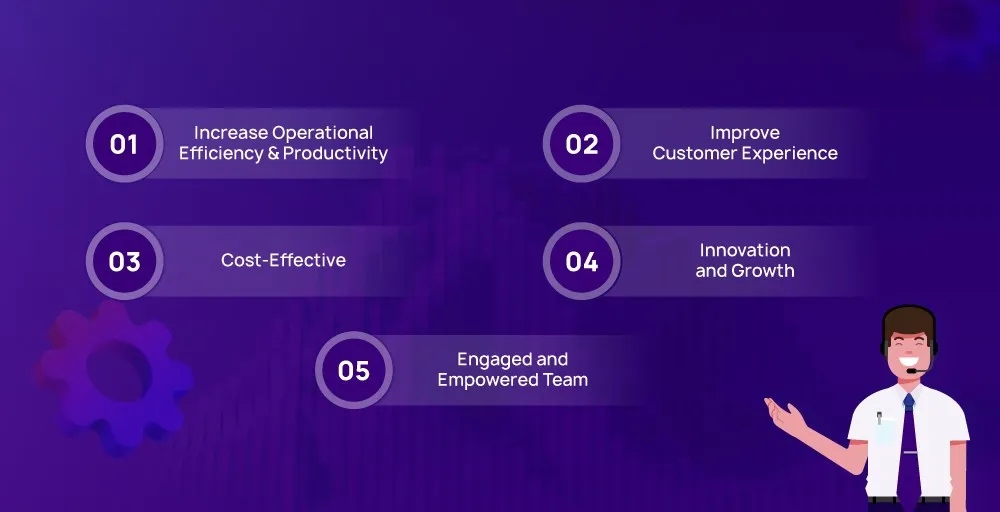
1. Increase Operational Efficiency and Productivity
Enterprise transformation can increase operational efficiency and business productivity by using technologies like AI. It allows companies to streamline business operations, decrease manual labor, reduce waiting times, and improve overall productivity.
This transformation leads to higher business efficiency and productivity through streamlined processes and automation of repetitive tasks. This enables employees to concentrate on high-value activities instead of manual or administrative tasks, which can increase operational efficiency.
2. Improve Customer Experience
The ultimate goal of an enterprise transformation is to enhance the customer service experience. Personalized and quick customer service is necessary to satisfy customers, and enterprise transformation allows businesses to achieve these goals and improve the customer experience.
Enterprise transformation allows businesses to leverage technology or strategies to meet customer expectations with the help of data analytics. It personalizes customer service, improves customer experiences, builds trust and loyalty, and leads businesses to sustainable growth.
3. Cost-effective
Enterprise transformation is a cost-effective method to enhance customer experience and increase business growth. It requires an investment while adopting transformation, but it saves costs in the long term.
Enterprise transformation allows businesses to automate processes, optimize available resource allocation, and reduce waste, which leads to low operating costs. Decreased operational costs boost a business’s profitability ratio over time.
4. Innovation and Growth
Enterprise transformation encourages employees for creativity, experimentation, and continuous improvement and promotes business growth and innovation.
By investing in new technologies and adopting new processes, businesses can innovate and unlock opportunities to increase revenue and expand their business.
5. Engaged and Empowered Team
Enterprise transformation involves training programs, skill development, and empowering the employees to enhance new skills and capacity.
This enables employees to contribute more effectively. New business systems or technology may also attract or retain employees for continuous learning and growth.
What Are The Strategies For Successful Enterprise Transformation?
The strategy for successful enterprise transformation is to transform a current business into a targeted business. Successful enterprise transformation includes digital adaptation, process optimization, and a customer-focused approach.
For a successful enterprise transformation, the business should take several strategies.
1. Set Clear Objectives and Strategy
Clear objectives are a key to enterprise transformation. First, identify the areas for change in the current state and set clear objectives for the future targeted state of an enterprise.
Select a transformation component or area aligned with the strategy objectives, such as digital, solution, or data.
2. Engage Stakeholders and Employees
You actively engage stakeholders and employees in the transformation process for effective outcomes. You should get stakeholders and align them with the strategic objectives of transformation.
Communicate with your employees, showing their efforts involved in the transaction process and how it benefits enterprises.
3. Adopt Change Across Multiple Areas
Adopting change means adopting a customer-focused approach. It involves understanding customers’ needs and preferences and finding appropriate people with sufficient skills to make changes.
Businesses can adopt new technologies, such as mobile, cloud, AI, etc., to improve customer experience and re-establish marketing, sales, and customer support strategies to enhance the customer journey.
4. Establish Effective Governance and Monitoring
Establish clear governance to guide the transformation process. Good governance is a list of rules to follow in every phase of transformation.
You should monitor the transformation phases continuously to track the strategy’s performance for better outcomes.
5. Drive Value and Sustainability
You should explain what value transformation will bring to a business. Encourage a flexible and adaptive business structure that develops a way to drive and sustain value over the long run.
With this, businesses can transform, create long-term value, and better manage business change.
What Are The Essential Components Of An Enterprise Transformation Roadmap?
The enterprise transformation roadmap is a plan to transform your business from its current stage to its targeted stage. It consists of several components and guides businesses to transform with optimized resource allocation.
The essential components of an enterprise transformation roadmap are explained below in detail:
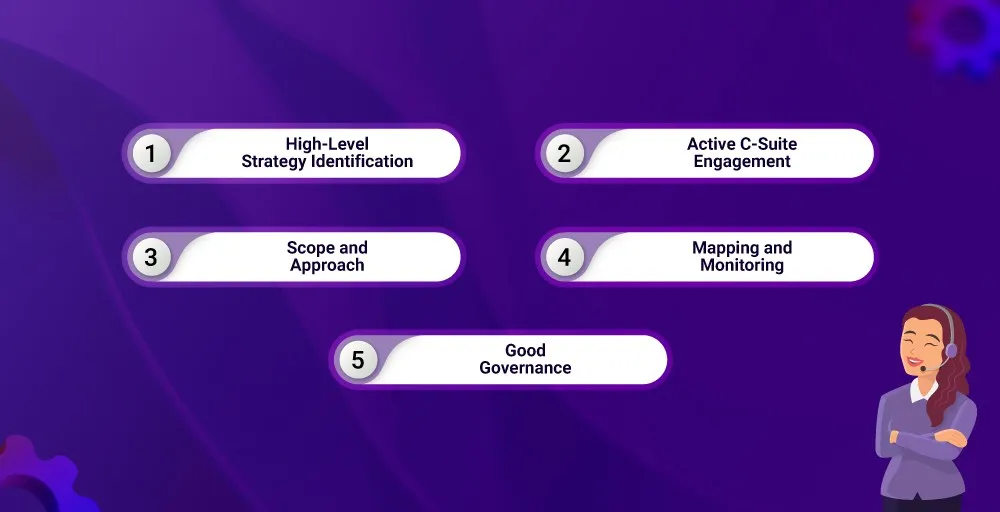
1. High-level Strategy Identification
Identifying and developing a high-level strategy is essential for creating an enterprise transformation roadmap. Before developing an enterprise roadmap, you must consider short—and long-term goals, vision, desired future outcomes, and the company’s broad vision.
Using the current phases, build targeted phases with each step to transform the enterprise. Without a strategy, enterprise transformation may not succeed, so start by developing a strategy for enterprise transformation.
2. Active C-suite Engagement
After building a high-level strategy, you envision where you are going. The next steps are getting approval and engaging the rest of your company’s senior stakeholders.
You should ensure the stability of the company structures and have the C-suite’s support throughout the process. Engaging the C-suite is essential while developing an enterprise transformation roadmap because transformation can’t succeed without their engagement.
3. Scope and Approach
The scope and approaches to developing an enterprise transformation roadmap are unlimited. An approach is a way of transforming your business. After knowing the strategy, figuring out how to achieve it is essential.
You have to decide the scope to be transformed and the approaches to develop an enterprise transformation roadmap. The approach should be extreme, involving removing and replacing the old business with a new one.
4. Mapping and Monitoring
Mapping and continuous monitoring are essential for an effective enterprise transformation roadmap. The roadmap guides you from your current business to your targeted business.
Mapping your roadmap progress lets you observe the transformation process and manage necessary funds. You can monitor an enterprise transformation process using various metrics for better business transformation.
5. Good Governance
Good governance is the rules and regulations for every project phase. Good governance and change management guide the transformation journey and ensure alignment with the objectives.
Governance is essential at every level, including technical, executive, development, and delivery teams. It helps to manage risk.
How Cloud Telephony System Can Support Your Enterprise Transformation Strategy
Cloud telephony systems play a significant role in enterprise transformation strategy. They are a cost-effective method for offering flexibility and scalability to your enterprise.
Cloud telephony systems integrate with multiple channels and make it easy for employees to communicate with customers. To expand your business, you can add unlimited international numbers with cloud telephony systems. It offers the opportunity for your business to expand globally.
It is filled with advanced features such as global calling, unified callbox, IVR (Interactive Voice Response), call forwarding, call analytics, etc., which help enhance customer experiences and build trust and loyalty toward your business.
Likewise, Cloud telephony systems are a changing need for a business that is flexible for both business and customers. If you also plan to transform your enterprise with a cloud telephony solution, you can choose KrispCall.
Wrapping Up
Enterprise transformation is transferring business to drive innovation and growth in a fast-paced business environment. It helps increase operational efficiency, improve customer experience, reduce operating costs, boost sales income, and drive business growth and innovation.
For a successful enterprise transformation, businesses should set clear objectives and strategies, adopt changes on various aspects of stakeholders and employees, establish effective governance, and create and sustain value for the long term.💫
Additionally, KrispCall would be a reliable option for your business for digital enterprise transformation as it offers advanced features to improve customer experience, sales, and innovation.
FAQs
What is a transformation strategy?
A transformation strategy is a plan or approach designed to change a business’s operations. It may involve team structures, core technologies, product and service development, decision-making processes, and selling strategies.
What is digital enterprise transformation?
Digital enterprise transformation means changing a business by integrating new digital technology and solutions into every business area. It is done to transform the way business operates and improve customer experience.
What is enterprise agile transformation?
Enterprise agile transformation is the process of changing the entire business structure, strategy, people, processes, and technology of a business based on enterprise agile strategy.
What are the primary business transformations?
The primary business transformations are:
- Digital transformation
- Data transformation
- Solution transformation
- Cultural transformation
- Agile transformation
- Customer experience transformation
How do I measure my enterprise transformation’s success?
You can measure your enterprise transformation’s success rate by following metrics:
- ROI (Return on Investment)
- Employee Engagement and Adoption Rates
- Customer Satisfaction and Experience
- Operational Efficiency
- Innovation Rate




